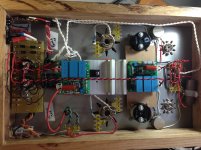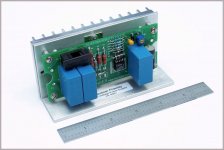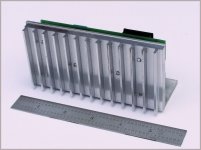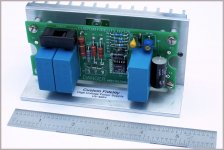Do you see any issues with joining the commons of two 21st Century Maida's together? I want to use one regulator for my input stage & phase splitter and a second regulator for my output stage.
That should be fine. They can even be supplied by the same raw supply if need be. That would mean they share all terminals except the +Vout terminal.
~Tom
Hello Bekim,
I can't comment on the sound quality just yet - I need approx two weeks to finish building my first channel.
More importantly, the Maida puts out very little ripple and the noise floor is extremely low. The regulator also has a soft start, which will help tube life.
I will report back on the sound as soon as I get the first channel up and running.
I can't comment on the sound quality just yet - I need approx two weeks to finish building my first channel.
More importantly, the Maida puts out very little ripple and the noise floor is extremely low. The regulator also has a soft start, which will help tube life.
I will report back on the sound as soon as I get the first channel up and running.
Getting rid of the mains hum on the B+ makes a huge improvement. Also, the low output impedance of the regulator results in a firmer bass. The two combine to a presentation that I personally enjoy: Clean highs, natural midrange, firm bass, good sound stage, and dead quiet in quiet passages. Going from an LC filtered supply to my 21st Century Maida Regulator made a huge difference in my 300B amp.
But, of course, I'm biased...
~Tom
But, of course, I'm biased...
~Tom
Tom,
I will be using the 21st Maida reg. I received from you a few weeks ago to drive two 12B4A tubes with CCS on the anodes in my linestage. Total current draw will be approx. 40mA.
I am doing some simulations with PSU Designer now.
How much shunt current will I have to add to represent your regulator in the simulations? 1ma?
As far as I remember, the Salas reg. needs quite a substantial shunt current to work. If I have understood the latest MAIDA docs correctly, this one needs next to nothing?
I will be using the 21st Maida reg. I received from you a few weeks ago to drive two 12B4A tubes with CCS on the anodes in my linestage. Total current draw will be approx. 40mA.
I am doing some simulations with PSU Designer now.
How much shunt current will I have to add to represent your regulator in the simulations? 1ma?
As far as I remember, the Salas reg. needs quite a substantial shunt current to work. If I have understood the latest MAIDA docs correctly, this one needs next to nothing?
C4 can probably be an 1 uF electrolytic. However, I would not increase the capacitance. Recall that C4 is charged to a bit above the output voltage. If the output voltage is driven towards zero (as it would be in case of a momentary short circuit or big current spike), the only thing that protects the IC in that case is the transient suppressor, D3. In those conditions, D3 basically gets to handle all the energy stored in C4.
The other thing is that there's no advantage of increasing C4. Bigger isn't always better. If I were to increase any capacitor in the circuit, it would probably be C2. You'll get slightly better transient response with a bigger cap there.
My standard recommendation is to leave the 21st Century Maida Regulator as-designed and put a 10 uF where the B+ enters the load circuit (amplifier, preamp, whatever).
~Tom
The other thing is that there's no advantage of increasing C4. Bigger isn't always better. If I were to increase any capacitor in the circuit, it would probably be C2. You'll get slightly better transient response with a bigger cap there.
My standard recommendation is to leave the 21st Century Maida Regulator as-designed and put a 10 uF where the B+ enters the load circuit (amplifier, preamp, whatever).
~Tom
As some of you have probably noticed already, the STW12NK95Z MOSFET is reaching end of life. In other words, STMicro is no longer making it.
I do maintain a small stock of them to fill orders that include this device, so no worries there.
If you can't find the STW12NK95Z, I suggest trying the STW13N95K3. It's available at Mouser, Newark, and Digikey. It looks like the STW13N95K3 will actually perform slightly better than the STW12NK95Z due to its lower capacitance and higher SOA limits.
~Tom
I do maintain a small stock of them to fill orders that include this device, so no worries there.
If you can't find the STW12NK95Z, I suggest trying the STW13N95K3. It's available at Mouser, Newark, and Digikey. It looks like the STW13N95K3 will actually perform slightly better than the STW12NK95Z due to its lower capacitance and higher SOA limits.
~Tom
Last edited:
My version of the Maida.
Hi all:
I've played around with the app note LB-47 for several years now and have
made several proto-types in the past. But thanks to Tom's fine work and inspiration I've revisited this project. I wanted a "goto block" for my pro-audio
tube projects. This design comes in 2 offerings of a high power (no external heat sink) and a low power version. The low power is for preamp or microphone projects. The high power version handles loads up to 200mA. Let me know what you think. All comments appreciated.
RonL
Hi all:
I've played around with the app note LB-47 for several years now and have
made several proto-types in the past. But thanks to Tom's fine work and inspiration I've revisited this project. I wanted a "goto block" for my pro-audio
tube projects. This design comes in 2 offerings of a high power (no external heat sink) and a low power version. The low power is for preamp or microphone projects. The high power version handles loads up to 200mA. Let me know what you think. All comments appreciated.
RonL
Attachments
Hi Tom:
I have been familiar with LB-47 since the early 90's. I've built quite a
few versions for use in my pre-amps ( Nash Audio, Vacuum tube preamps, equalizers, compressors, preamps ) and other projects. The Maida design that your and my design is based on, is as far as I know is open source. Use of the LT-3080 and MOSFET cascode was a modern application of parts that were not around at the time LB-47 was published. I will give you credit for using them as I did in the posting. But there is a lot of design on my part involved. The proper PCB layout for low noise, the use of through hole components for HV and high power. Also the mechanical and thermal design. I will, cite you and Michael Maida for your contribution if I decide to offer them for sale as a stand alone product. I don't have a problem with that.
Thanks
RonL
I have been familiar with LB-47 since the early 90's. I've built quite a
few versions for use in my pre-amps ( Nash Audio, Vacuum tube preamps, equalizers, compressors, preamps ) and other projects. The Maida design that your and my design is based on, is as far as I know is open source. Use of the LT-3080 and MOSFET cascode was a modern application of parts that were not around at the time LB-47 was published. I will give you credit for using them as I did in the posting. But there is a lot of design on my part involved. The proper PCB layout for low noise, the use of through hole components for HV and high power. Also the mechanical and thermal design. I will, cite you and Michael Maida for your contribution if I decide to offer them for sale as a stand alone product. I don't have a problem with that.
Thanks
RonL
Rlaury said:"Let me know what you think. All comments appreciated."
I think you hijacked someone else thread to promote your self and a product that appears to closely resemble Tom's. I am not sure what the rules are on this board, but I would hope a moderator takes a close look at your behavior!
Me
I think you hijacked someone else thread to promote your self and a product that appears to closely resemble Tom's. I am not sure what the rules are on this board, but I would hope a moderator takes a close look at your behavior!
Me
- Home
- Vendor's Bazaar
- 21st Century Maida Regulator



